Maui is the tale of two islands. All you need to do is look at a map of Maui to see that it’s actually two islands fused at the waists. The larger island is to the east. It’s home to the towering Haleakala Volcano, it's National Park and the Road to Hana. The smaller island sits to the west. It’s home to former whaling stations that have now turned into some of Hawaii’s nicest resort towns.
So, if you’re looking to be pampered in a resort, you simply head to an old whaling station on the western island. Looking for adventure? Well, there’s no better place to look than the towering cinder cones of Haleakala on the eastern island. But, if you’re looking for whales, then you’ll have to head over to the western side of Maui. Or you can go on a road trip to the east on the world-famous Road to Hana. It’s as if the two halves of Maui are two different islands altogether.
But there is one thing that both “islands” share -- beaches. Maui has more beaches than any other island in Hawaii. In fact, the island has more than 30 miles of pristine beachy coastline. That means you could throw down your blanket every day for 30 days straight and never repeat a beach spot. And all these beaches give you ample opportunity to have your own secluded tropical strip of sand for a day.
And it’s this mixture of secluded beaches, adventure and pampering hospitality that makes Maui the most romantic island in Hawaii. Visit the island and you’re likely to see newlyweds, honeymooners, and couples holding hands in every direction. That means you’ll be battling love birds to find the most impressive sunsets on the island. Use this list to get a leg up.
Haleakala National Park
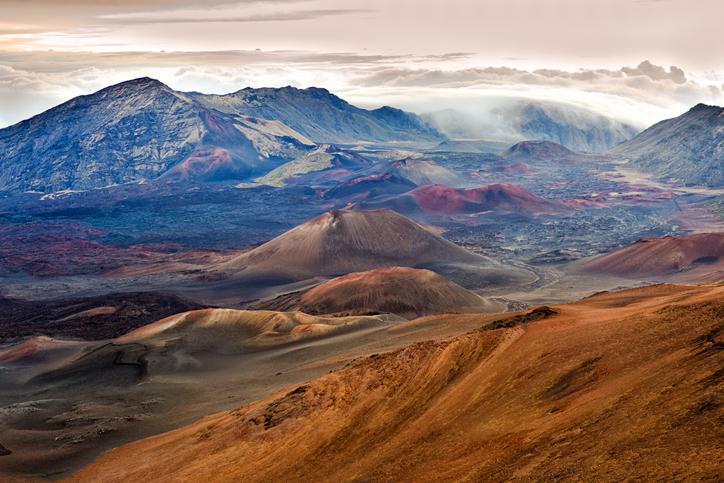 The very top of Maui’s massive 10,000-foot mountain is a still-active volcano. It’s also a national park and a must-visit during your Maui vacation. And you don’t have to worry about any lava flows. The last eruption took place centuries ago.
The very top of Maui’s massive 10,000-foot mountain is a still-active volcano. It’s also a national park and a must-visit during your Maui vacation. And you don’t have to worry about any lava flows. The last eruption took place centuries ago.
But hiking around inside a still-active volcano adds to the sense of adventure in this otherworldly landscape. This top of the mountain is a barren cinder cone that seems to go on forever, and minerals have mixed with the volcanic rocks to create a stunning array of colors.
Blues, purples, reds, blacks, oranges and even greens seem to shimmer in the tropical sunlight. And all of those colors dance when the sun sets on Maui. The warming light of the evening sky makes the entire moonscape sparkle. There’s no more of a surreal place to watch the sunset than at the top of Haleakala on the island of Maui.
If you’re really lucky, it will be a cloudy day on Maui. You’ll ascend the mountain to burst through the clouds at the National Park, and then you’ll be able to watch the sunset into the clouds below. It can make the whole cinder cone feel like an island in the sky.
You should be prepared for a sunset on the top of this massive mountain. Despite the mountain’s tropical setting, the air gets rather cold up at 10,000 feet of elevation, and there will certainly be a chill in the air as the sun dips below the horizon. Make sure to bring something warm to wear, or you’ll risk watching the amazing sunset from behind the heater vents of your car’s dashboard.
Kapalua Bay
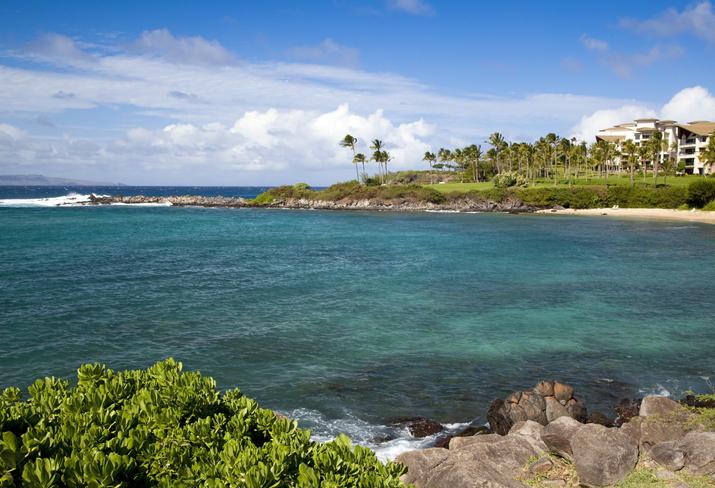 Kapalua Bay sits on the rugged northwest coast of the island of Maui. It’s an absolutely breathtaking place to visit any time of day, and you can often see humpback whales breaching during breeding season from January to March, but the sunsets here are stunning. One visit and you’ll know why it once earned the title of America’s Best Beach.
Kapalua Bay sits on the rugged northwest coast of the island of Maui. It’s an absolutely breathtaking place to visit any time of day, and you can often see humpback whales breaching during breeding season from January to March, but the sunsets here are stunning. One visit and you’ll know why it once earned the title of America’s Best Beach.
It’s a rather small beach inside a half-moon bay. It’s surrounded by black volcanic rock outcroppings, and the water is full of colorful reefs. The white sand of the beach adds a dramatic slash to the incredibly green coastline. And the Kapalua Coast Trail weaves its way along the sand just inland from the water.
But it’s those volcanic rocky outcroppings on each end of the beach that makes for perhaps the most beautiful sunset in all of Maui. Those outcroppings catch small tidal pools, and, as the sun sets, those tidal pools become placid mirrors. They amplify the incredible colors of the west coast sky.
Oranges, pinks, reds, and purples dance upon the tidal pools. The volcanic rocks make for a great visual juxtaposition to the softness of the whole scene. It certainly makes for a social media-worthy picture that is sure to make your friends back home envious.
Po’olenalena Beach
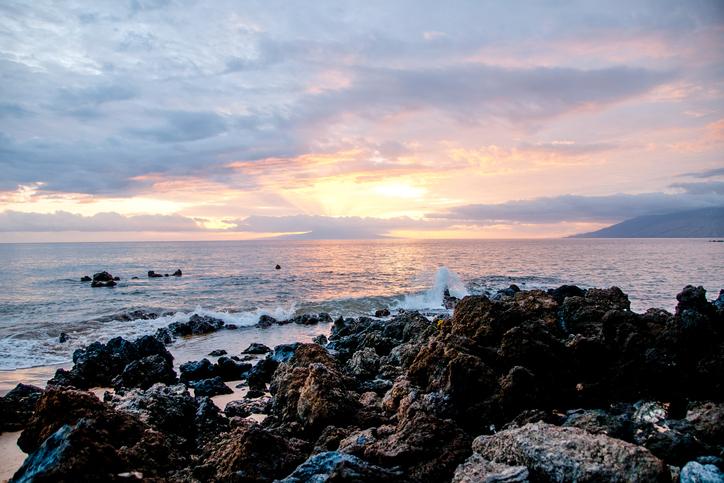 If you follow the wedding photographers at sunset, then they’ll probably take you down to Po’olenalena Beach. Situated near the more popular Big Beach at Makena State Park, this lesser-known strip of white sand is perfect for a sunset shoot. You won’t find many people down here which allows you to enjoy the sunset in perfect isolation. You’ll just have to let the wedding photographers do their jobs.
If you follow the wedding photographers at sunset, then they’ll probably take you down to Po’olenalena Beach. Situated near the more popular Big Beach at Makena State Park, this lesser-known strip of white sand is perfect for a sunset shoot. You won’t find many people down here which allows you to enjoy the sunset in perfect isolation. You’ll just have to let the wedding photographers do their jobs.
To say this beach is on the west coast is a bit misleading. Remember, Maui is essentially two islands fused together, so you’ll find this beach on the west coast of the larger eastern island. That means you get uninterrupted views of the sun dipping into the ocean from the beautiful white sand of this secluded beach.
The rough waves smooth themselves out on the wide beach to make for a glowing reflection of the sun’s tropical colors. You can watch as the wet sand changes from red to orange to purple as the night takes over the island. And a few volcanic rocks jut through the surf to give the whole scene a bit of perspective.
Lahaina Pali Trail
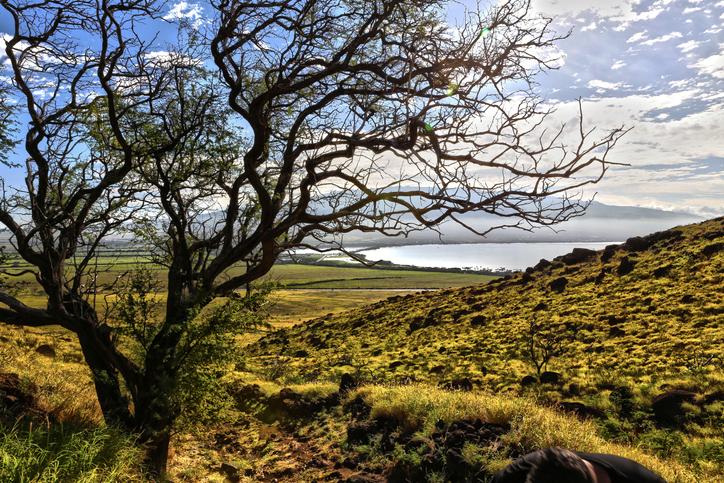 You’re going to have to pack a flashlight for this sunset hike, and you’ll have to earn the views, but it’s totally worth it. You’ll get sweeping views out over Lanai as the sun sets into the Pacific Ocean beyond, and you get to see it all from a “pali.” In Hawaiian, pali mean steep cliff or hill.
You’re going to have to pack a flashlight for this sunset hike, and you’ll have to earn the views, but it’s totally worth it. You’ll get sweeping views out over Lanai as the sun sets into the Pacific Ocean beyond, and you get to see it all from a “pali.” In Hawaiian, pali mean steep cliff or hill.
There are two trailheads for this steep and strenuous hike. You can find the start of the eastern trail just off the Honoapiilani Highway, but don’t make the common mistake of parking just off the highway. You can find a small parking lot at the trailhead itself.
The western side of the one-way trail can be found at Ukumehame Beach State Park. There are bathroom facilities here as well as a larger and easier to find the parking lot. This is our recommended trailhead because the slope up to the midway point of the trail is a lot easier to handle. If you’re coming from the east side, prepare for quite an uphill battle.
The middle of the trail is what you’re shooting for. Kealaloloa Ridge gives you incredibly sweeping views of the beach and ocean down below. And it makes for a great whale watching spot between the months of January and March. You’ll get uninterrupted views of Maui’s windmills, Haleakala, Molokini Crater, and Lanai. And you get to watch the sunset on all of it.
Just remember that flashlight, or be smart enough to descend back down to the car while there’s still residual light left in the sky. You don’t want to be stranded on such a steep “pali” after dark.
Keawakapu Beach
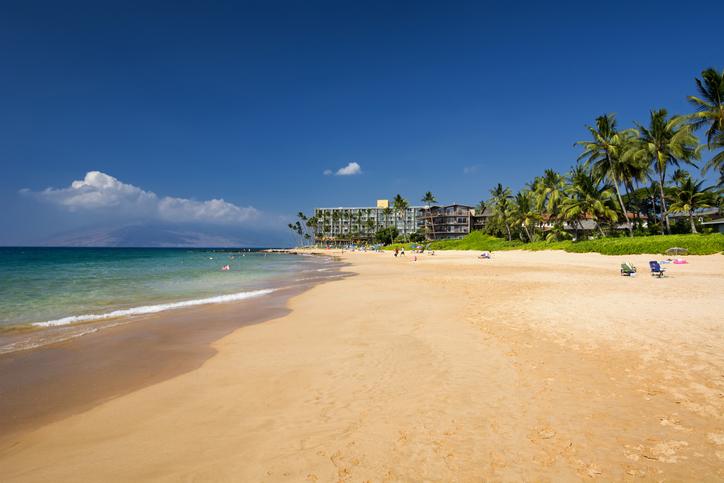 This beautiful half-mile stretch of white sand is surprisingly isolated which makes it great for a romantic sunset. Just don’t plan on swimming at this stunning beach because the water here tends to get a bit rough, and there are no lifeguards on duty. But, if you’re looking to simply enjoy the views from a beach blanket with a loved one or a few close friends, then this is the beach for you.
This beautiful half-mile stretch of white sand is surprisingly isolated which makes it great for a romantic sunset. Just don’t plan on swimming at this stunning beach because the water here tends to get a bit rough, and there are no lifeguards on duty. But, if you’re looking to simply enjoy the views from a beach blanket with a loved one or a few close friends, then this is the beach for you.
This beach is developed, but a local ordinance keeps the buildings a good distance from the sand, so it makes the beach feel a bit remote. But all the infrastructure here makes finding this Kihei beach simple.
On the north side of the beach, you’ll find little tide pools that are perfect for exploring before the sunsets. They also turn into little reflective pools when the sun begins to dip below the horizon, so get that camera ready. And there is an artificial reef made up of 150 antique cars dumped just 400 yards from the sand. You might catch a car-loving diver emerging from the water during your visit.
But it is the breathtaking vista that makes this beach perfect for a sunset. The island of Maui wraps around to give your sunset view incredibly impressive perspective. And the islands of Lanai and Kaho’olawe become silhouettes in the distance.